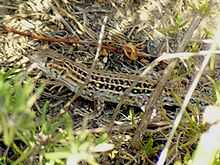Acanthodactylus erythrurus
| Acanthodactylus erythrurus | |
|---|---|
 | |
| Conservation status | |
| Scientific classification | |
| Kingdom: | Animalia |
| Phylum: | Chordata |
| Subphylum: | Vertebrata |
| Class: | Reptilia |
| Order: | Squamata |
| Suborder: | Sauria |
| Infraorder: | Scincomorpha |
| Family: | Lacertidae |
| Genus: | Acanthodactylus |
| Species: | A. erythrurus |
| Binomial name | |
| Acanthodactylus erythrurus (Schinz, 1833) | |
| Synonyms | |
| |
Acanthodactylus erythrurus, commonly known as the spiny-footed lizard, is a species of lacertid lizard[1] endemic to northwestern Africa and the Iberian Peninsula.[3] It is considered to be the fastest member of the huge Lacertidae family. Its common name refers to the spines that are arranged like a comb on the toes of its hind legs.
Geographic range
A. erythrurus is native to Europe in Gibraltar, Portugal, and Spain, and is native to Africa in Algeria, Morocco, and Tunisia.[2]
Habitat
Though the spiny-footed lizard prefers dry and sparsely vegetated regions,[3] it is not restricted to arid terrain, and it is not uncommon to find it in other environments.[1]
Description
The spiny-footed lizard's coloration and the pattern of its spots are extremely variable.[3] As result, zoologists have from time to time classified such variations as separate species.
Behavior
The spiny-footed lizard, like other members of the genus Acanthodactylus, may defend itself aggressively and bite tenaciously, if one tries to catch it. Individuals are continuously involved in skirmishes with other members of the species and the males strenuously defend the borders of their territories.
Reproduction
A. erythrurus is oviparous.[1] The number of eggs in a clutch varies from three to seven. The average total length (including tail) of a sexually mature adult of the species is 18 to 20 cm (7.1 to 7.9 in).[3]
Subspecies
The following three subspecies are recognized, including the nominotypical subspecies:[2]
- Acanthodactylus erythrurus atlanticus Boulenger, 1918 - Morocco
- Acanthodactylus erythrurus belli Gray, 1845 - Algeria and Morocco
- Acanthodactylus erythrurus erythrurus (Schinz, 1833) - Iberian Peninsula
References
- ↑ 1.0 1.1 1.2 1.3 Slimani T, Miras JAM, Joger U, El Mouden H, Geniez P. (2006). Acanthodactylus erythrurus. In: IUCN 2008. IUCN Red List of Threatened Species. Retrieved 19 February 2009.
- ↑ 2.0 2.1 2.2 The Reptile Database. www.reptile-database.org.
- ↑ 3.0 3.1 3.2 3.3 Arnold EN, Burton JA. 1978. A Field Guide to the Reptiles and Amphibians of Britain and Europe. London: Collins. 272 pp. + Plates 1-40. ISBN 0-00-219318-3. (Acanthodactylus erythrurus, p. 122 + Plate 17 + Map 63).
Further reading
- Salvador A. 1982. A revision of the lizards of the genus Acanthodactylus (Sauria: Lacertidae). Bonner Zoologische Monographien (16): 1-167. (Acanthodactylus erythrurus, pp. 57-65, Figures 23-25, Map 11).
- Schinz HR. 1833. Naturgeschichte und Abbildungen der Reptilien. Leipzig: Brodtmann. iv + 240 pp. + Plates 1-102. (Lacerta erythrurus, p. 102 + Plate 38).
